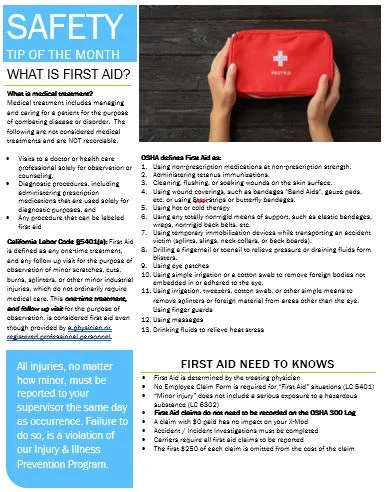Defining First Aid Claims in Workers’ Compensation
First aid is one of the most frequent topics of conversation I have with my clients. The confusion typically arises from two main issues:
The WCIRB (Workers’ Compensation Insurance Rating Bureau in California) rule changes, starting in 2019, which deducts $250 from ALL claims in the X-Mod calculation (more on this later).
The differences between a First Aid designation for Workers’ Compensation insurance purposes, and a first aid incident under the OSHA definitions (listed below).
If any of this is already sounding foreign to you, rest assured, we will start with the basics.
What is a First Aid claim?
As I mentioned, there are two categories that need to be separated out to understand what you (as the employer) need to do when you believe a claim should be considered First Aid.
I. Workers’ Compensation
California Labor Code §5401(a) spells out a definition of how to categorize a First Aid claim:
Any one-time treatment, and any follow up visit for the purpose of observation of minor scratches, cuts, burns, splinters, or other minor industrial injuries, which do not ordinarily require medical care. This one-time treatment, and follow up visit for the purpose of observation, is considered first aid even though provided by a physician or registered professional personnel.
Great, now what about all the other issues that arise when an employee seeks treatment two or fewer times? What if they are prescribed medication that isn’t over the counter or taken off work or given work restrictions for a few days between visits?
Hint: both of these examples would drive the claim out of a First Aid designation, even if all the other criteria are met.
Typically, if the treatment meets the criteria of First Aid, the treating physician will say so on their medical report. Even if they don’t, claims adjusters are trained to spot these types of claims. As with any definition with complex factors, there are gray areas. However, due to the rule changes discussed below, you will no longer need to be concerned with whether a claim is designated as First Aid for workers’ compensation claim purposes.
II. OSHA
Many employers are aware they need to keep an OSHA 300 log of their occupational injuries. OSHA does not require First Aid claims to be logged for reporting purposes. So, how does OSHA define First Aid?
Using non-prescription medications at non-prescription strength.
Administering tetanus immunizations.
Cleaning, flushing, or soaking wounds on the skin surface.
Using wound coverings, such as bandages "Band Aids", gauze pads, etc. or using Steri-strips or butterfly bandages.
Using hot or cold therapy
Using any totally non-rigid means of support, such as elastic bandages, wraps, non-rigid back belts. etc.
Using temporary immobilization devices while transporting an accident victim (splints, slings, neck collars, or back boards).
Drilling a fingernail or toenail to relieve pressure or draining fluids form blisters.
Using eye patches
Using simple irrigation or a cotton swab to remove foreign bodies not embedded in or adhered to the eye.
Using irrigation, tweezers, cotton swab, or other simple means to remove splinters or foreign material from areas other than the eye. Using finger guards
Using massages
Drinking fluids to relieve heat stress
Even if a claim meets these criteria, and the employee seeks medical treatment, you are still required to file the claim with your insurance carrier.
What effect do these differences have for employers?
I. Workers Compensation
Prior to the 2019 rule changes (from the WCIRB), employers would frequently pay for First Aid claims out of pocket to avoid having the costs count against them for X-Mod and/ or insurance premium purposes
Now that all claims are reduced by $250, which most First Aid claims do not exceed, it makes sense to have the carrier pick up the costs. This is because the WCIRB does not have a First Aid designation that helps your business with regard to their X-Mod formula. The way premiums and X-Mods are calculated are outside the scope of this article, but if your firm pays for medical cost associated with a First Aid claim, those payments are still required to be reported to the insurance carrier so they may pass it along to the WCIRB.
Using their formula, the first $250 on all claims are excluded, whether you pay for them or the carrier does.
II. OSHA
The biggest difference in how an employer handles First Aid claims is that you do not need to record them on your OSHA log, assuming the injury or incident meets the aforementioned criteria in the definitions above; however, you do need to report the claim to your insurance carrier if the employee seeks medical treatment.
What should employers do moving forward?
I. Workers’ Compensation
Employers no longer have an incentive to pay for First Aid claims out of pocket, and should defer those costs to their carriers—who typically have the benefit of contracted rates with the medical providers.
On the Workers’ Compensation side, you should be reporting all claims where your employee seeks medical treatment where a Doctor’s First Report (Form 5021) is generated—including First Aid.
It is important to note that employers are NOT required to provide a DWC-1 to the injured worker on First Aid claims (Labor Code §5401(a)), nor are they required to submit an Employer’s First Report (Form 5021) on First Aid claims (Labor Code § 6409.1)—although they still need to report the claim as outlined.
II. OSHA
For OSHA recording, you need to determine whether the claim meets their First Aid criteria and record those claims accordingly. There may be an injury that does not meet First Aid criteria from the insurance carrier perspective, but it does meet the criteria for OSHA recording purposes—take note that there may be differences.
Keep your OSHA logs up to date and make sure you are reviewing each incident under their separate definitions. There may be significant overlap between the types of treatment considered First Aid for OSHA and that for Workers’ Compensation claims purposes, but you need only concern yourself with their specific definitions (1-13, above) for your OSHA 300 Form.
Additional resources
Department of Industrial Relation – Division of Workers’ Compensation: https://www.dir.ca.gov/dwc/firstaid.htm
OSHA Recording: https://www.osha.gov/laws-regs/regulations/standardnumber/1904/1904.7
WCIRB Experience Rating Changes https://www.wcirb.com/erp2019
Click on the image below for a First Aid Safety Tip training

